The Panasonic Lumix DMC-GX1 is a new premium compact system digital camera. The Panasonic GX1 features a Four Thirds sized 16 megapixel Live MOS sensor, a built-in pop-up flash and a 3.0" inch touchscreen LCD display with a resolution of 460,000 dots. The DMC-GX1 also offers full HD video capture at 1920 x 1080 at 60i (NTSC) / 50i (PAL) in AVCHD format with stereo sound and full-time auto-focus, 4.2fps continuous shooting, a speedy contrast-detect auto-focus system that can lock onto your subject in approximately 0.09 second, a Venus Engine processor, RAW support and an ISO range of 160-12800. The Panasonic GX1 is available in two classic colors - gray and black.
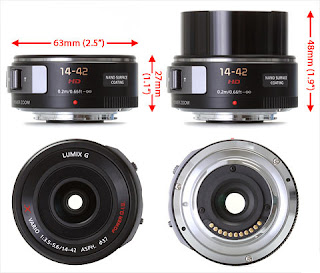 I tested the Panasonic GX 1 with the new Panasonic Lumix G X Vario PZ 14-42mm f/3.5-5.6 lens. Panasonic's Lumix G X Vario PZ 14-42mm f/3.5-5.6 Power O.I.S. lens is an ultra-compact retractable pancake 3x zoom lens (28-84mm equivalent in 35mm and full-frame formats) for Lumix Micro 4/3 cameras that's only about the size and weight of the Panasonic 20mm pancake lens. It's 2.4 x 1.87"/61 x 47.7mm (the short dimension shrinks to 1.05"/26.8mm when the power is off). It weighs just 3.35 oz/95 g. Not only is it extremely small and light, but the "X" in this lens means high performance specifications. Including electric-powered zoom operation, autofocus during movie recording, nano surface coating that drastically reduces ghosting and flare, and Power O.I.S. (Optical Image Stabilization) for vastly improving image sharpness and blur reduction. Two ED lens elements compensate for chromatic aberration, and the silent design makes this an ideal lens for shooting video.
I tested the Panasonic GX 1 with the new Panasonic Lumix G X Vario PZ 14-42mm f/3.5-5.6 lens. Panasonic's Lumix G X Vario PZ 14-42mm f/3.5-5.6 Power O.I.S. lens is an ultra-compact retractable pancake 3x zoom lens (28-84mm equivalent in 35mm and full-frame formats) for Lumix Micro 4/3 cameras that's only about the size and weight of the Panasonic 20mm pancake lens. It's 2.4 x 1.87"/61 x 47.7mm (the short dimension shrinks to 1.05"/26.8mm when the power is off). It weighs just 3.35 oz/95 g. Not only is it extremely small and light, but the "X" in this lens means high performance specifications. Including electric-powered zoom operation, autofocus during movie recording, nano surface coating that drastically reduces ghosting and flare, and Power O.I.S. (Optical Image Stabilization) for vastly improving image sharpness and blur reduction. Two ED lens elements compensate for chromatic aberration, and the silent design makes this an ideal lens for shooting video.The Panasonic GX1 picks up where the popular GF1 camera left off. Similar to the GF1, the GX1 is a small, compact interchangeable-lens system camera with all the functionality, controls and degree of customization that enthusiasts could want. The GF1 grew in popularity among DSLR owners looking for a second 'go-anywhere' camera because of the camera's high image quality, comprehensive external controls and its relatively compact Micro Four Thirds lens offerings. Therefore, the GX1 is quite a departure from the GF2 and GF3 models, which were designed to be the smallest and lightest compact system cameras on the market and were also aimed predominantly at people upgrading from compact point-and-shoot cameras. The GX1 does inherit some key features from the other two models, however, its most notable similarity is its touch-screen interface. But if you're not a fan of touch sensitive LCD screens (like me) the plethora of dedicated external buttons gives you the option to choose whether or not you would like to utilize this feature.
The aluminum-bodied Panasonic GX1 is quite durable and despite its added complexity, it is a highly portable camera. While the new Lumix G X Vario PZ 14-42mm power-zoom lens is attached, the GX1 is still not much bigger than some high-end compacts. In terms of body-only, the GX1 is very similar in size to the Sony NEX-7.
Comparing the GF1 and GX1 side-by-side, there are actually few differences between the two in terms of their external design, perhaps a real testament to just how much the GF1 got it right when it was released over 2 years ago. Starting with the front view of the GX1, there is a new and chunky hand-grip on the right hand side that aids in ease of use when handling. However, I would prefer to of had the hand-grip extended to the full height of the camera to accommodate more than two or three fingers. This feature coincides with the useful rubberized thumb-rest on the rear of the camera. The GX1 sports a more traditional design than the GF3, characterized by more angular lines and a matte exterior. In terms of design, it occupies a position mid-way between the overtly retro Olympus PEN series design and the futuristic style of the Sony NEX-7.
 |
| Panasonic Lumix GX1 vs. Panasonic Lumix GF1 |
The lenses are still where Panasonic have really shrunk tin size of the overall system, and the 14-42mm power-zoom lens is no exception. Providing an equivalent wide-angle focal length of 28-82mm, this lens is a good partner for the GX1, keeping the size of the overall system to a bare minimum and really looking the part. You can just about squeeze this combination into a coat pocket or handbag which is highly impressive for a camera with DSLR characteristics.
To achieve such a small lens with such a wide focal range, Panasonic has completely removed the traditional zoom and manual focus rings. Panasonic replaced them with forefinger-operated switches, hence the power zoom moniker. When using this GX1 this immediately makes it operate more like a compact camera with a zoom lever, however it is inevitably slower and less precise than a conventional zoom lens.
Just like the GF1, GF2 and GF3 before it, the GX1 doesn't have a built-in viewfinder, with just the LCD screen on the rear providing an out-of-the-box solution for composing your images. It does have an external hotshoe which allows the use of the optical viewfinder accessory, although you have to additionally purchase this optional accessory and it does prevent the use of an external flashgun at the same time.
The Micro Four Thirds system is now well-established, with a lot of lenses on offer from Panasonic and Olympus that cover most of the popular focal lengths. You can also use regular Four Thirds lenses or even Leica D lenses via optional adapters from either Panasonic or third-parties, but lenses that are not compatible with the GX1's Contrast AF function can only be used with manual focusing and cannot use the Tracking AF, AFc (Auto Focus Continuous) or Continuous AF functions. Optical image stabilization is supplied via the lens, rather than being built-in to the camera body, a key difference between the Panasonic and Olympus systems. Note that the14-42mm power-zoom lens does offer image stabilization, although there's no switch on the lens barrel to turn it manually on and off, just three different modes accessible through the DMC-GX1's menu system.
When enabled, the Panasonic Lumix DMC-GX1 automatically compensates for camera shake, which is a slight blurring of the image that typically occurs at slow shutter speeds when the camera is hand held. There are three different modes, Mode 1 is on all the time including image composition, Mode 2 is only on when you press the shutter button, and Mode 3 compensates for up and down movements only (which in turn allows you to pan the camera). You don't notice that the camera is actually doing anything different when anti-shake is turned on, just that you can use slower shutter speeds than normal and still take sharp photos.
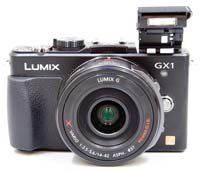 On the front of the Panasonic Lumix DMC-GX1 is a small focus-assist and self-timer indicator lamp, lens release button, metal lens mount and the already mentioned hand-grip. On the bottom is a metal tripod socket, importantly in-line with the middle of the lens barrel, and the shared battery compartment and SD/SDHC/SDXC memory card slot. The GX1 manages just over 300 shots using the supplied rechargeable Li-ion battery. On the right-hand side are ports for the remote socket, HDMI and AV Out/Digital connections, with small metal eyelets on either side of the body for the supplied camera strap.
On the front of the Panasonic Lumix DMC-GX1 is a small focus-assist and self-timer indicator lamp, lens release button, metal lens mount and the already mentioned hand-grip. On the bottom is a metal tripod socket, importantly in-line with the middle of the lens barrel, and the shared battery compartment and SD/SDHC/SDXC memory card slot. The GX1 manages just over 300 shots using the supplied rechargeable Li-ion battery. On the right-hand side are ports for the remote socket, HDMI and AV Out/Digital connections, with small metal eyelets on either side of the body for the supplied camera strap.
Unfortunately, Panasonic does not include a HDMI cable as standard in the box, which means that you'll have to purchase one separately to take advantage of this camera's HD connectivity. On the left-hand side is s small microphone. The top of the GX1 houses a cleverly designed built-in pop-up flash, stereo speakers, flash hotshoe, shooting mode dial with integrated on/off switch, dedicated button for the Intelligent Auto mode which lights blue when turned on, tactile shutter button, and a one-touch movie button. The Panasonic GX1 has a dedicated button on the rear for opening the pop-up flash. Given the small size of the GX1, fitting a built-in flash was no mean feat, as proven by the double-hinged design which is quite a technical achievement. Although not particularly powerful with a guide number of just 7.6, the GX1's flash is perfectly adequate for fill-in effects at close-quarters.
The shooting mode dial offers the usual selection of Program, Aperture Priority, Shutter Priority, and Manual for the more experienced photographer. An optional exposure meter can be displayed in the P/A/S/M shooting modes which graphically shows the relationship between shutter speed and aperture, with a color-coded warning that alerts users when the settings are not in the proper range. The more beginner-friendly Scene modes are also available.
Additionally there are 4 custom modes which allow you to configure your favorite camera settings and quickly access them, with the first accessible via C1 and the other 3 via C2.
 |
| Scene Mode - Flower IMG 01 |
 |
| Scene Mode - Flower IMG 02 |
 |
| Scene Mode - Architecture IMG 01 |
 |
| Scene Mode - Architecture IMG 02 |
 |
| Scene Mode - Architecture IMG 03 |
 |
| Scene Mode - Architecture IMG 04 |
 |
| Scene Mode - Object IMG 01 |
 |
| Scene Mode - Object IMG 02 |
 |
| Scene Mode - Object IMG 03 |
Completing the various shooting modes is the new range of Creative Controls, denoted by an artist's palette, with 8 different options - Expressive, Retro, High Key, Low Key, Sepia, High Dynamic, Toy and Miniature - on offer. Some are more useful than others, and I'm not quite sure why these modes deserve their own special place on the shooting mode menu, rather than being grouped together with the Photo Styles in the Main Menu. It's presumably because you lose control of the exposure and other key settings when using the Creative Controls, whereas the 6 available Photo Styles still allow full control of the camera's settings. Below are sample images I shot of a tree outside of the New York Public Library using each of the 8 different Creative Controls to give you an idea of what they can do.
 |
| Expressive Mode |
 |
| Retro Mode |
 |
| High Key Mode |
 |
| Low Key Mode |
 |
| Sepia Mode |
 |
| High Dynamic Mode |
 |
| Toy Camera Mode |
 |
| Miniature Mode |
Accessed via the dedicated red colored "iA" button on top of the camera, Intelligent Auto mode makes things as easy as possible for the complete beginner. It allows you to point and shoot the camera without having to worry about choosing the right scene mode or settings. Intelligent Auto Mode automatically determines a number of key criteria when taking a picture, including selecting the most appropriate scene mode (from 5 commonly used presets) and ISO speed, and turning face detection (up to 15 faces), image stabilization and quick auto-focus on. The Intelligent Auto Plus Mode also includes Intelligent Exposure, which increases exposure only in the under-exposed areas of the image, Digital Red-eye, which automatically detects and removes red-eye, and AF Tracking, which continually tracks a moving subject and keeps it in focus, without you having to hold the shutter button halfway down as on most other cameras.
 |
| Intelligent Auto Mode IMG 01 |
 |
| Intelligent Auto Mode IMG 02 |
 |
| Intelligent Auto Mode IMG 03 |
 |
| Intelligent Auto Mode IMG 04 |
 |
| Intelligent Auto Mode IMG 05 |
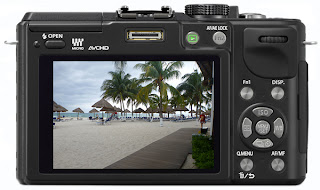 The rear of the Panasonic DMC-GX1 is dominated by the large 3 inch LCD screen. The 460K pixel, high-resolution screen coped admirably with the majority of lighting conditions, aided by an anti-reflective coating. This screen is a great improvement on cameras with the usual 230K dot resolution, even being nice to use in low-light. The LCD operates at 60fps, twice the usual speed, which helps make it relatively flicker-free. The Auto Power LCD function automatically detects the current lighting conditions and boosts the LCD backlighting by up to 40% when shooting outdoors in bright sunshine, helping to keep the screen visible, although the lack of a built-in optical viewfinder is a hindrance on the rare occasions that the rear LCD is difficult to see.
The rear of the Panasonic DMC-GX1 is dominated by the large 3 inch LCD screen. The 460K pixel, high-resolution screen coped admirably with the majority of lighting conditions, aided by an anti-reflective coating. This screen is a great improvement on cameras with the usual 230K dot resolution, even being nice to use in low-light. The LCD operates at 60fps, twice the usual speed, which helps make it relatively flicker-free. The Auto Power LCD function automatically detects the current lighting conditions and boosts the LCD backlighting by up to 40% when shooting outdoors in bright sunshine, helping to keep the screen visible, although the lack of a built-in optical viewfinder is a hindrance on the rare occasions that the rear LCD is difficult to see.
One of the GX1's main innovations is its touchscreen interface, with a revamped GUI that's easy on the eye. Panasonic have wisely restricted the amount of things that you can do by interacting with the screen, and indeed you can still operate everything on the camera without having to push and prod the LCD at all. You would be missing out on a lot of genuinely useful functionality that really improves the shooting experience, though, so we suggest that you experiment before dismissing it out-of-hand. There's also a brand new Level Gauge which automatically detects the horizontal and vertical angle of view, useful for keeping your horizons straight or creatively wonky.
The most immediately noticeable function is the ability to use the 1-area AF mode to focus on your main subject simply by touching it on the LCD. If the subject then moves, the GX1 cleverly follows it around the screen using the the AF tracking function. If the subject exits the frame entirely, simply recompose and tap it again to start focusing. Impressive stuff that makes focusing on off-center subjects fast and intuitive. It is a little too easy to accidentally press the screen and set the focus point to the wrong area for the current subject, but a simple tap of the new Reset button will center the AF point (or you can turn this feature off altogether).
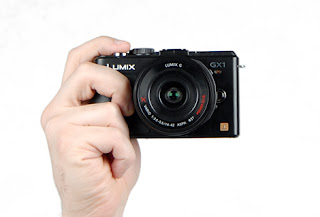 The size of the AF point itself can also be changed via an interactive onscreen slider or the rear scroll wheel. If Face Detection is enabled, the 1-area AF point can be manually set to a person's eye to help ensure that the most important part of a portrait is in focus. If Multi-area AF rather than 1-area AF is enabled, then you can select a group of 4, 5 or 6 AF points from 9 different areas, again providing some manual control over what is traditionally a rather hit and miss affair. The Pinpoint AF auto-focus area mode allows you to touch the area of the frame where your subject is, whereupon said area gets magnified in order to allow you to set the focus point with pinpoint accuracy using a second touch. While this method is obviously slower than the others, it can be very useful when shooting, say, a portrait with shallow depth of field where you will want to make sure focus is on the subject’s eyes rather than her nose, ears or eyebrows.
The size of the AF point itself can also be changed via an interactive onscreen slider or the rear scroll wheel. If Face Detection is enabled, the 1-area AF point can be manually set to a person's eye to help ensure that the most important part of a portrait is in focus. If Multi-area AF rather than 1-area AF is enabled, then you can select a group of 4, 5 or 6 AF points from 9 different areas, again providing some manual control over what is traditionally a rather hit and miss affair. The Pinpoint AF auto-focus area mode allows you to touch the area of the frame where your subject is, whereupon said area gets magnified in order to allow you to set the focus point with pinpoint accuracy using a second touch. While this method is obviously slower than the others, it can be very useful when shooting, say, a portrait with shallow depth of field where you will want to make sure focus is on the subject’s eyes rather than her nose, ears or eyebrows.
When Intelligent Auto is switched on, the GX1 changes the scene mode used when you touch the subject, for example selecting portrait mode if you touch a face and macro mode if you touch a close-up flower. If you prefer to manually focus rather than use the snappy AF, you can magnify any part of the subject by 1x, 5x or 10x by simply dragging the image around the screen. The final touchscreen ability from an image composition point of view is the ability to release the shutter, with a small icon on the right hand screen enabling this functionality, and then a single on-screen tap all that's required to take the picture.
Most of the menu options can be changed via the touchscreen interface, notably the Quick Menu and the Info Display menu - the main exception to this rule is the Main Menu, which is still mostly controlled via the navigation buttons. You can also control image playback by touching the screen, with the ability to tap a thumbnail to see the full-size version, scroll through your images by dragging them from side to side, and magnifying them up to 16x. The GX1 also offers a clever Touch Tab on the right-hand-side of the LCD which provides access to five icons - by default touch-zoom, touch-shutter, Function 3 and Function 4 - with the latter two allowing even more customisation of the camera.
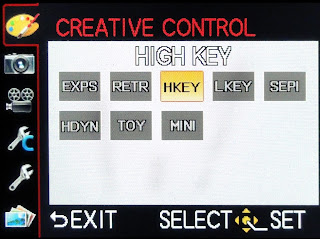

Above the LCD screen is the aforementioned Flash button for popping-up the built-in flash, the port for the optional DMW-LVF2 electronic viewfinder, and two buttons for Playback and AF/AE Lock. The latter also doubles up as the second customisable Function button, although we'd suggest leaving it as the AF/AE control given its handy position. To the right of the LCD screen is a thumb-operated control dial for setting the aperture and/or shutter speed and also selecting menu options. Cleverly this dial can be pushed in to toggle between the aperture/shutter speed and exposure compensation. Below this is the Function 1 button, again customisable to suit you way of working, alongside a Display button which toggles detailed settings information about each picture on and off, such as the ISO rating and aperture / shutter speed.
Underneath is a traditional 4-way navigation D-Pad system with Menu/Set button in the centre. Pressing left, up, right and down on the D-Pad buttons selects AF Mode, ISO Speed, White Balance and Burst / Self-timer options respectively. The main menu system on the DMC-GX1 is straight-forward to use and is accessed by pressing the Menu/Set button in the middle of the navigation D-Pad. There are five main menus represented by large icons, Record, Motion Picture, Custom, Setup and Playback. As an indication of how configurable the GX1 is, the Custom menu has 32 different options, allowing you to fine-tune this camera to suit your way of working. If you have never used a digital camera before, or you're upgrading from a more basic model, reading the easy-to-follow manual before you start is a good idea. Unfortunately Panasonic have only chosen to supply a basic guide in printed format, with the full manual only available as a PDF on the product CD.
Underneath again is a combined Q. Menu/Delete/Reset button. The Q.Menu button provides quick access to most of the principal controls via an onscreen menu, which displays by default the aspect ratio, size, quality, metering and focus mode, and you can also configure it to include up to 10 out of 19 available settings simply by dragging and dropping the onscreen icons. You can still access all of these options from the main menu system too if you wish. The AF/MF button completes the rear of the GX1, allowing you to quickly choose from AF Single, AF Flexible, AF Continuous and Manual Focus modes. AF Flexible is a new mode which conventionally locks the focus when the shutter button is half-pressed, but then automatically resets it if the subject moves.
The GX1's Intelligent Resolution mode makes a standard image look like a higher resolution one by processing the contour areas, texture areas and smooth areas individually. There are three available strengths - low, standard and high - and an Extended option which increase the zoom range. Despite all the clever behind-the-scenes processing, it's fairly easy to tell which image was taken with Intelligent Resolution turned on and which one with it turned off due to unwanted artifacts appearing, particularly if viewing onscreen at 100% magnification. While the difference isn't quite so apparent on a print up to A3 in size, we're not convinced enough to recommend regularly using it.
Intelligent Dynamic adjusts the exposure setting to record more detail in the highlights and shadows, with three strengths available - low, standard and high. It's actually very effective for high-contrast scenes when the camera tends to blow-out the highlights and block-up the shadows. You can see some examples for both Intelligent Resolution and Intelligent Dynamic on the Image Quality page.
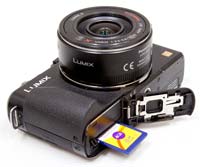 The GX1 offers Full 1080i HD 1920 x 1080 movies and 720p HD 1280 x 720 movies at 60fps, both in the AVCHD (MPEG-4/H.264) format. In addition it can also record MP4 movies at 1920x1080, 1280x720 and 640x480 pixels, all at 30fps, useful as this format can currently be shared more easily. AVCHD offers almost double the recording time in HD quality, but software support is still a little thin on the ground. Panasonic describe it as the best mode for playing back on a HD TV direct from the camera, with the newly-supported MP4 format is best for email and playing on a computer.
The GX1 offers Full 1080i HD 1920 x 1080 movies and 720p HD 1280 x 720 movies at 60fps, both in the AVCHD (MPEG-4/H.264) format. In addition it can also record MP4 movies at 1920x1080, 1280x720 and 640x480 pixels, all at 30fps, useful as this format can currently be shared more easily. AVCHD offers almost double the recording time in HD quality, but software support is still a little thin on the ground. Panasonic describe it as the best mode for playing back on a HD TV direct from the camera, with the newly-supported MP4 format is best for email and playing on a computer.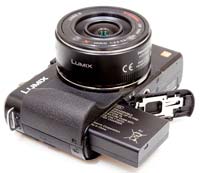 There's also a useful wind cut function which blocks out most of the noise from background wind and you can also display and adjust the built-in microphone level. The thumb-operated dedicated movie button on the top makes it simple to start record video footage at whatever quality level is currently selected. The HDMI port allows you to connect the GX1 to a high-def TV set, but only if you purchase the optional HDMI mini-cable. You can extract a frame from a movie during playback and save it as a small still image.
There's also a useful wind cut function which blocks out most of the noise from background wind and you can also display and adjust the built-in microphone level. The thumb-operated dedicated movie button on the top makes it simple to start record video footage at whatever quality level is currently selected. The HDMI port allows you to connect the GX1 to a high-def TV set, but only if you purchase the optional HDMI mini-cable. You can extract a frame from a movie during playback and save it as a small still image.
The Panasonic GX1's Intelligent Auto mode works for movies as well as for still photos. Simply press the iA button on top of the camera, then the Movie Record button. The Intelligent Scene Selector automatically determines the most suitable Scene mode from five options - Portrait, Scenery, Low Light and Close-up or Normal modes. Face Detection automatically detects a face in the frame and adjusts the focus, exposure, contrast, and skin complexion. Intelligent Exposure continually checks the ambient light level and adjusts the exposure setting as conditions change to prevent blown highlights and blocked shadows. The Optical Image Stabilizer helps prevent blurring from hand-shake when using a compatible lens. Note that the GX1 doesn't offer any control over aperture or shutter speed during video recording, a rather glaring omission for a 2012 interchangeable-lens camera.
You can use any zoom lens during recording with focusing set as for still images. On the negative side, you'll find that if you choose continuous auto-focus, areas of the video will be blurred before becoming sharp again as the camera tries to refocus. On a more positive note, the the GX1 is quite fast at re-focusing (although not as fast as for still images), and having this system is much better than not being able to auto-focus at all, as with most current DSLR cameras that offer video recording. Hand-holding the GX1 during movie recording inevitably leads to obvious shake, despite the optical image stabilizer on compatible lenses, so for best results you'll need a dedicated video tripod. One great benefit of the touch-screen control system is that Touch Auto Focusing is available in movie recording, enabling pro-level rack-like focusing simply by pointing at the subject on the LCD screen. You can also use features like Photo Styles, metering modes, Intelligent Resolution and Intelligent Dynamic Range for video as well as stills.
Unlike a conventional DSLR camera which uses a phase detection auto-focus system, the DMC-GX1 employs the same Contrast AF that is commonly used by compact cameras. Panasonic have published marketing data which suggests that the GX1's AF is as fast, if not faster, than a typical DSLR camera's, with a claimed speed of just 0.09 second when used with certain lenses, including the 14-42mm power-zoom that we tested the GX1 with. In practice we noticed very little difference in speed between the GX1 and a DSLR, and there were also very few occasions when the GX1 failed to lock onto the subject, especially when using the centre AF point. There are a wide range of AF modes on offer, including multiple-area AF with up to 23 focus areas, 1-area AF with a selectable focus area, Face Detection, AF Tracking and Pinpoint. The GX1 also has a useful Quick AF function that begins focusing as soon as you point the camera.
The start-up time from turning the Lumix DMC-GX1 on to being ready to take a photo is very impressive at less than 0.5 seconds. It takes about 1 second to store a JPEG image, allowing you to keep shooting as they are being recorded onto the memory card - there is a barely perceptible LCD blackout between each image. Storing a single RAW image takes around 4 seconds, but thankfully it doesn't lock up the camera in any way - you can use the menu system or shoot another image while the first file is being written to memory. The Panasonic Lumix DMC-GX1 has a pretty good Burst mode which enables you to take 4.2 frames per second for an unlimited number of JPEG images at the highest image quality, or 7 RAW images. There's also a faster 20fps mode, but the images are only recorded at 4 megapixels.
 Once you have captured a photo, the Panasonic Lumix DMC-GX1 has an average range of options when it comes to playing, reviewing and managing your images. You can instantly scroll through the images that you have taken, view thumbnails (up to 30 onscreen at the same time and in a Calendar view), zoom in and out up to 16x magnification, view slideshows, delete, protect, trim, resize, copy and rotate an image. You can also select favourite images, change an image's aspect ratio, divide a video and set the print order. The Display icon toggles detailed settings information about each picture on and off, such as the ISO rating and aperture / shutter speed, and there is a small brightness histogram available during shooting and RGBY histogram during playback if enabled in the menu. You can also turn on guide-lines to help with composition and flashing highlights which indicate any over-exposed areas of the image.
Once you have captured a photo, the Panasonic Lumix DMC-GX1 has an average range of options when it comes to playing, reviewing and managing your images. You can instantly scroll through the images that you have taken, view thumbnails (up to 30 onscreen at the same time and in a Calendar view), zoom in and out up to 16x magnification, view slideshows, delete, protect, trim, resize, copy and rotate an image. You can also select favourite images, change an image's aspect ratio, divide a video and set the print order. The Display icon toggles detailed settings information about each picture on and off, such as the ISO rating and aperture / shutter speed, and there is a small brightness histogram available during shooting and RGBY histogram during playback if enabled in the menu. You can also turn on guide-lines to help with composition and flashing highlights which indicate any over-exposed areas of the image.
Overall, the Panasonic Lumix DMC-GX1 combines the more traditional handling of the original GF1 model with more up-to-date features from the GF3 and G3 cameras and some brand new options like MP4 video support, Touch Tab, AF Flexible mode and the level gauge.
Yes, this product is in stock on our website or at our storefront location.
For pricing and availability:
- Panasonic Lumix DMC-GX1 (Body Only)
- Panasonic Lumix G X Vario PZ 14-42mm f/3.5-5.6 Lens
- Panasonic Lumix DMC-GX1 with the Panasonic PZ 14-42mm f/3.5-5.6 Lens Kit
Yes, this product is in stock on our website or at our storefront location.
For pricing and availability:
- Panasonic Lumix DMC-GX1 (Body Only)
- Panasonic Lumix G X Vario PZ 14-42mm f/3.5-5.6 Lens
- Panasonic Lumix DMC-GX1 with the Panasonic PZ 14-42mm f/3.5-5.6 Lens Kit








No comments:
Post a Comment